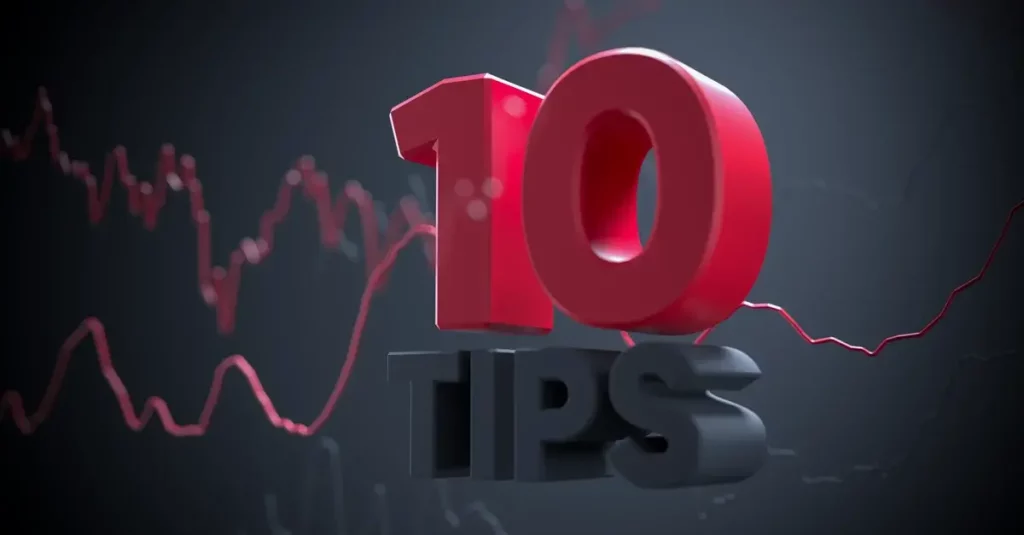
Trading de Forex: 10 consejos que realmente funcionan
Contenidos
El comercio de divisas es un campo ventajoso para el desarrollo financiero debido a su gran liquidez y una presencia continua en el mercado. Sin embargo, gestionar eficazmente los mercados de divisas requiere planificación estratégica y una ejecución rigurosa, no solo conocimiento de los fundamentos. Este artículo ofrece una guía útil y práctica para mejorar significativamente la eficiencia y los resultados finales de sus operaciones de Forex. Desde la gestión de riesgos hasta la preparación psicológica, estos consejos proporcionan a operadores principiantes y experimentados herramientas para operar de forma inteligente y eficaz.
Lista de 10 consejos esenciales para operar en Forex
- Adoptar la gestión de riesgos
- Manténgase informado sobre los movimientos del mercado
- Desarrollar una estrategia comercial consistente
- Domine las técnicas de análisis de mercado
- Centrarse en un segmento de mercado específico
- Comprenda y utilice el apalancamiento con prudencia
- Practique en una cuenta demo antes de empezar a operar
- Adopte herramientas tecnológicas
- Optimizar los tiempos de negociación
- Invertir en el aprendizaje continuo
Desglosando los consejos
1. Adoptar la gestión de riesgos
El trading de Forex se basa en gran medida en prácticas sólidas de gestión de riesgos, que son la base de estrategias de trading rentables. A continuación, se presentan los componentes clave y la mecánica básica de un enfoque sólido de gestión de riesgos:
Establecer el riesgo máximo por operación
Se trata de gestionar el grado de riesgo de capital que implica una operación. Normalmente, conviene arriesgar entre el 1 % y el 2 % de su capital total en cada operación. Por ejemplo, si su cuenta de operaciones muestra $10 000, arriesgaría solo entre $100 y $200 por transacción. En caso de varias transacciones fallidas consecutivas, este principio ayuda a proteger su cuenta de pérdidas significativas.
Relación riesgo-recompensa
El concepto compara la posible pérdida de una operación (riesgo) con el posible beneficio. Con una buena relación riesgo-recompensa, digamos 1:3, el objetivo es obtener tres dólares de ganancia por cada dólar arriesgado. Este enfoque garantiza que las transacciones rentables compensen las pérdidas, incluso si no todas tienen éxito, generando así una ganancia neta.
Uso de órdenes de stop-loss
Un instrumento clave para controlar el riesgo es una orden stop-loss. Si el mercado se vuelve en su contra, cierra automáticamente la operación a un precio determinado para evitar pérdidas adicionales. Por ejemplo, si compra un par de divisas a 1,3050 y establece un stop-loss en 1,2950, su operación se cerrará inmediatamente si el precio alcanza 1,2950, lo que limita sus pérdidas.
Revisión y ajuste periódico de las estrategias
La gestión de riesgos no es algo que se configura y se olvida. Depende de su éxito en las operaciones y de que las fluctuaciones del mercado sean monitoreadas y ajustadas constantemente. Para adaptarse al mercado Forex en constante evolución, debe evaluar periódicamente sus transacciones y ajustar su tolerancia al riesgo.
2. Manténgase informado sobre los movimientos del mercado
El éxito en el trading de Forex depende principalmente de su capacidad para reconocer y reaccionar ante las fluctuaciones del mercado, que se ven influenciadas en gran medida por los acontecimientos y las tendencias económicas mundiales. Tomar decisiones acertadas y mantenerse al día requiere diversas herramientas y recursos:
Calendarios económicos
ForexFactory Otros sitios web ofrecen calendarios económicos completos con los próximos eventos importantes, como la publicación del PIB, decisiones sobre las tasas de interés y datos laborales. Estos calendarios contienen abundantes pronósticos y resultados históricos, lo que permite a los operadores predecir las reacciones del mercado.
Servicios de noticias en tiempo real
Es muy útil suscribirse a sitios de noticias financieras como Bloomberg, Reuters o CNBC, que cubren eventos en tiempo real. Estos sitios web ofrecen noticias de última hora, opiniones de expertos y la información más actualizada sobre eventos de la economía mundial que pueden impactar los mercados Forex.
Sitios web como Trading Economics brindan herramientas para monitorear y evaluar diversos indicadores económicos en numerosos países, arrojando así luz sobre la salud económica mundial.
Muchos brókers de Forex ofrecen a sus clientes estudios y análisis de mercado. Estos suelen incluir estudios técnicos, informes diarios de mercado e indicaciones para operar.
Aplicaciones como Investing.com o las versiones móviles de Bloomberg y Reuters son útiles para los inversores que necesitan mantenerse informados en cualquier lugar. Estas herramientas incluyen estudios de mercado, noticias en tiempo real y estadísticas financieras.
Redes sociales y foros en línea
Plataformas como X (anteriormente Twitter) pueden ser sorprendentemente útiles para obtener actualizaciones rápidas. Seguir a analistas respetados, operadores experimentados e instituciones financieras puede ofrecer información oportuna. Además, participar en foros en línea dedicados al trading de Forex puede brindar una idea del sentimiento del mercado.
3. Desarrollar una estrategia comercial consistente
El éxito a largo plazo en el mercado Forex depende del desarrollo y mantenimiento de una estrategia consistente. estrategia comercial Diversos enfoques de trading se adaptan a distintos tipos de personalidad, tolerancia al riesgo y disponibilidad de tiempo. Analicemos algunas de las técnicas de trading más utilizadas:
Comercio intradía
El day trading implica completar numerosas transacciones en una sola jornada, cerrando las posiciones al final del día para evitar el riesgo de fluctuaciones importantes durante la noche. Los operadores que prefieren decisiones rápidas y retornos instantáneos, y que pueden pasar toda la jornada observando los mercados, encontrarán este método adecuado. Un buen day trading depende del análisis técnico, la creación de gráficos en tiempo real y mantenerse al día con los eventos económicos. Entre los instrumentos necesarios se encuentran una conexión rápida a internet, varios monitores para supervisar varios activos simultáneamente y un proveedor confiable. plataforma de negociación Esto hace posible la ejecución rápida de órdenes.
Especulación
El scalping, que a menudo mantiene posiciones durante solo minutos o incluso segundos, es una técnica de trading centrada en realizar varias operaciones para beneficiarse de pequeñas fluctuaciones de precios. Es adecuado para operadores que se adaptan a un entorno de trading frenético y toman decisiones rápidas y sin pensarlo dos veces. Generalmente, empleando un apalancamiento significativo para magnificar las ganancias de pequeñas fluctuaciones de precios, los scalpers operan en gráficos a muy corto plazo, con intervalos de uno o cinco minutos. El éxito del scalping depende fundamentalmente de la rapidez de ejecución y la disponibilidad de fuentes de datos en tiempo real, ya que los retrasos pueden afectar considerablemente la rentabilidad.
Comercio de swing
Al mantener posiciones durante días o semanas para captar las fluctuaciones del mercado, el swing trading equilibra la rápida velocidad del day trading con la estrategia a largo plazo del trading de posición. Los operadores que pueden examinar los mercados varias veces a lo largo del día, pero no pueden operar a tiempo completo, encontrarán este método adecuado. Los swing traders necesitan conocer los patrones gráficos, los indicadores y los movimientos generales del mercado, ya que a menudo dependen de una combinación de análisis técnico y fundamental. Para maximizar las posibles ganancias de las fluctuaciones del mercado, intentan identificar el inicio de un movimiento de precios y mantenerlo hasta que la tendencia se desvanezca.
Debe probar su estrategia a fondo antes de implementarla en el mercado real. Un entorno demo o backtesting le permite replicar operaciones sin riesgo financiero para evaluar el éxito de su estrategia. Aun así, la formación es fundamental. Al comprender que el mercado Forex es dinámico y requiere un enfoque flexible, un operador exitoso está siempre dispuesto a modificar su estrategia en respuesta a las circunstancias cambiantes del mercado o a los cambios en su rendimiento. Igualmente cruciales son la dedicación y la paciencia necesarias para seguir su plan, especialmente en momentos difíciles. Es fundamental confiar en su estrategia cuidadosamente planificada, teniendo en cuenta que no todas las transacciones generarán ganancias. No obstante, la persistencia y la constancia en su estrategia guiarán su experiencia de trading a largo plazo.
4. Domina las técnicas de análisis de mercado
Desarrollar buenas estrategias de trading y tomar decisiones prudentes en Forex depende del dominio de las herramientas de análisis de mercado. En Forex, el análisis de mercado consiste en el estudio de numerosos elementos y señales que afectan al tipo de cambio. Esto abarca el análisis fundamental (es decir, la evaluación de datos económicos y noticias), así como el estudio técnico, que se centra en los patrones gráficos y el comportamiento histórico de los precios. Analicemos ahora estos elementos fundamentales con más detalle:
Análisis técnico
- Patrones y tendencias de gráficos: Conocer patrones gráficos como el de cabeza y hombros, triángulos o banderas puede ayudar a comprender posibles oscilaciones del mercado.
- Indicadores técnicos: Utilizando indicadores como medias móviles, bandas de Bollinger o la Índice de fuerza relativa (RSI) puede ayudar a identificar tendencias, impulso y posibles puntos de entrada y salida.
- Patrones de velas: Aprender a interpretar patrones de velas puede proporcionar un análisis profundo del estado de ánimo del mercado y las probables reversiones de precios.
Análisis fundamental
- Indicadores económicos: Estar atento a indicadores como el crecimiento del PIB, las tasas de interés, las tasas de desempleo y la inflación puede proporcionar pistas sobre la salud de la economía de un país y su impacto en su moneda.
- Eventos políticos y económicos: El mercado Forex puede verse muy influenciado por eventos políticos, cambios legislativos y datos económicos. Manténgase al día con los acontecimientos mundiales.
- Sentimiento del mercado: Las decisiones comerciales pueden verse afectadas al conocer la actitud general de los actores del mercado, ya sea optimista o negativa.
5. Centrarse en un segmento de mercado específico
Centrarse en un par de divisas o segmento de mercado específico, especialmente en pares importantes como el EUR/USD o el USD/JPY, le ayudará a mejorar sus habilidades y resultados de trading. Esta estrategia especializada proporciona estabilidad y liquidez, permitiéndole explorar las sutilezas de estos sectores específicos del mercado.
Análisis en profundidad
Al concentrarse en ciertos pares, podrá comprender a fondo las condiciones económicas y las políticas monetarias de cada país. Esto incluye estudiar cómo los eventos globales podrían afectar a estas divisas y adquirir experiencia en la interpretación de sus comportamientos de mercado e indicadores técnicos. Este nivel de análisis específico es más difícil de lograr cuando su atención se concentra en múltiples mercados.
Diversificación en el punto de mira
Sigue siendo importante diversificar dentro del área de interés elegida. Operar con varios pares de divisas, por ejemplo, podría ayudar a distribuir el riesgo si se concentra en los pares principales. Comprender las relaciones entre varios pares de divisas, como la correspondencia entre las fluctuaciones del EUR/USD y del EUR/GBP, también puede brindar una ventaja estratégica al proyectar las tendencias del mercado.
6. Comprenda y utilice el apalancamiento con prudencia
Aunque aumenta considerablemente las ganancias, el apalancamiento es una herramienta eficaz en el trading de Forex, pero conlleva mayores riesgos. Se invierte una pequeña parte del dinero propio y luego se pide prestado el resto a un corredor, lo que en esencia implica tomar prestado capital para invertir. La clave está en utilizar el apalancamiento con sensatez y comprender tanto los posibles beneficios como las posibles desventajas.
Comenzando con ratios de apalancamiento más bajos
Para principiantes, es prudente comenzar con ratios de apalancamiento más bajos. Este enfoque minimiza el riesgo mientras se familiariza con la dinámica del mercado. A medida que aumente su experiencia y confianza, puede considerar aumentar su apalancamiento con cautela.
Beneficios del uso del apalancamiento
- Eficiencia de capital: El apalancamiento le permite abrir posiciones más grandes que las que su propio capital permitiría, aumentando así potencialmente su retorno de la inversión.
- Potencial de ganancias mejorado: Al utilizar apalancamiento, incluso pequeñas oscilaciones de precios pueden generar grandes ganancias, especialmente en un mercado como Forex, donde las fluctuaciones son abundantes.
- Flexibilidad en la estrategia comercial: Para ciertos enfoques comerciales, el apalancamiento puede ser un instrumento estratégico que permite a los operadores obtener beneficios de las oscilaciones del mercado tanto a corto como a largo plazo.
You may also like

Posibles desventajas
- Pérdidas amplificadas: Así como el apalancamiento puede magnificar las ganancias, también puede magnificar las pérdidas. Una pequeña fluctuación adversa del mercado puede resultar en pérdidas sustanciales, que superen su inversión inicial.
- Llamadas de margen: Si el mercado se vuelve en contra de su posición, puede tener que hacer un llamado de margen y realizar más depósitos para mantener la posición abierta.
- Mayor estrés y riesgo: Especialmente en situaciones de mercado inciertas, gestionar una posición apalancada puede resultar peligroso y exigente.
Gestión de posiciones apalancadas
En el trading de Forex, el uso del apalancamiento exige adoptar buenas estrategias de gestión de riesgos. Las posiciones apalancadas conllevan riesgos inherentes, por lo que requieren una supervisión regular y minuciosa. Los rápidos cambios en las circunstancias del mercado exigen estar alerta para reaccionar con rapidez y acierto. Además, es necesario un sólido conocimiento de... Cómo funciona el apalancamiento Es crucial comprender el mercado Forex antes de incluirlo en su plan de trading. Conocer la mecánica, los riesgos y las técnicas óptimas de uso le ayudará a utilizar este instrumento en sus operaciones con conocimiento.
7. Practique en una cuenta demo antes de empezar a operar
Es fundamental practicar con una cuenta de prueba antes de entrar en el mercado Forex. Las cuentas demo ofrecen una oportunidad única y valiosa para experimentar la dinámica del mercado Forex sin correr el riesgo de perder dinero. Usar una cuenta demo puede ayudar tanto a principiantes como a operadores experimentados de muchas maneras:
Familiarización con las plataformas de negociación
Las diferentes plataformas de trading ofrecen diversas funciones y herramientas. Una cuenta demo te enseña a navegar y usar estos sitios con éxito. En plataformas como MetaTrader 4/5 o TradingView, puedes aprender y practicar el uso de herramientas de gráficos, indicadores y numerosos tipos de órdenes.
Estrategias de prueba y refinamiento
Las cuentas demo son el campo de pruebas perfecto para nuevas estrategias. En diferentes circunstancias de mercado, pruebe diversas estrategias como el day trading, el scalping o el swing trading y observe su rendimiento. Aplicar stop loss y take profit sin la presión de una pérdida financiera real también ayuda a comprender la gestión de riesgos en acción.
Comprender los movimientos del mercado
El mercado Forex se ve influenciado por los numerosos factores mencionados anteriormente. Al operar en un entorno demo, puede observar cómo los diversos factores afectan las fluctuaciones de las divisas y aprender a interpretar las señales del mercado sin la presión de los resultados con dinero real.
Desarrollar la confianza y la gestión emocional
Operar no solo implica riesgo financiero, sino también desafíos emocionales. Una cuenta demo ayuda a desarrollar la confianza necesaria para tomar decisiones en el mercado real. También permite practicar el control emocional y la disciplina, cualidades esenciales para operar con éxito.
Transición al trading en vivo
Tras un período de trading demo exitoso, podrías sentirte listo para empezar a operar en vivo. Sin embargo, es importante hacer una transición gradual. Empieza con pequeñas operaciones en una cuenta real para familiarizarte con los aspectos psicológicos de operar con dinero real.
Una cuenta demo es un componente vital para su crecimiento en el trading de Forex, no solo una herramienta de entrenamiento. En un entorno seguro y regulado, proporciona un entorno para el aprendizaje, la experimentación y el desarrollo de las habilidades y la confianza necesarias para operar con eficacia.
8. Adopte herramientas tecnológicas
En el frenético mercado Forex, su eficiencia y eficacia pueden mejorar considerablemente con el uso de herramientas tecnológicas modernas. Las herramientas adecuadas no solo simplificarán los análisis complejos, sino que también automatizarán las tareas habituales, permitiéndole concentrarse en la estrategia y la toma de decisiones. Las siguientes recomendaciones le ayudarán a maximizar estas herramientas:
Herramientas avanzadas de gráficos
Plataformas como MetaTrader ofrecen amplias capacidades para un análisis exhaustivo del mercado. Estos sistemas proporcionan a los operadores una colección de indicadores técnicos especializados y herramientas gráficas para que puedan estudiar detenidamente las tendencias y los movimientos de las divisas. Estas sofisticadas herramientas de gráficos permiten a los operadores encontrar posibles puntos de entrada y salida, guiando así sus decisiones basadas en el análisis técnico. La capacidad de estudiar los mercados con tanta precisión es muy útil, especialmente para identificar patrones y tendencias sutiles.
Automatización en el trading
En particular, para ciertos métodos de trading como el scalping, donde la rapidez en la toma de decisiones es vital, el uso de tecnologías de automatización, como bots de trading y sistemas automatizados, se ha vuelto más popular y útil. Estos sistemas automatizados pueden ejecutar transacciones según criterios predefinidos, eliminando así el sesgo emocional y garantizando la implementación consistente de las técnicas de trading. Si bien ofrecen ventajas como la velocidad y la eficiencia, los operadores deben vigilar estos sistemas. Es necesario realizar un seguimiento y ajustes regulares para alinearlos con las condiciones actuales del mercado y sus objetivos de trading personales.
Integrando la tecnología con la estrategia
La integración exitosa de la tecnología en el trading de Forex requiere un equilibrio armonioso. Si bien estas herramientas proporcionan eficiencia y profundidad analítica, deben complementar, en lugar de reemplazar, su conocimiento e intuición del mercado. Se trata de combinar la información de las herramientas tecnológicas con su comprensión del mercado. Por ejemplo, si bien los sistemas automatizados pueden gestionar tareas rutinarias o aspectos específicos de su estrategia, las decisiones clave de trading deben basarse en su propio análisis y criterio.
Al implementar inteligentemente tecnologías sofisticadas de gráficos y automatización en sus operaciones de Forex, puede mejorar su conocimiento del mercado, la eficiencia en la ejecución de operaciones y la consistencia de su estrategia. Recuerde que el objetivo final es utilizar la tecnología como un aliado eficaz en su aventura de trading, mejorando sus habilidades y su capacidad de toma de decisiones.
You may also like

9. Optimizar los tiempos de negociación
La actividad continua del trading de Forex ofrece oportunidades y desafíos únicos. Aunque el mercado opera las 24 horas, no todas las horas son ideales para operar. Su éxito será mucho mayor si sabe cuándo es el mejor momento para operar.
Horas pico de negociación
El mercado Forex alcanza su mayor actividad durante los periodos de solapamiento entre los principales mercados. Por ejemplo, el solapamiento entre el horario del mercado europeo y el estadounidense se considera uno de los mejores momentos para operar, especialmente para pares de divisas populares como el EUR/USD. Durante estos horarios, el aumento de liquidez se traduce en spreads más ajustados y movimientos del mercado potencialmente más predecibles.
Cómo evitar las horas de baja liquidez
Por el contrario, operar fuera de las horas punta (cuando los principales mercados están cerrados) puede presentar dificultades. Estos períodos suelen presentar menor liquidez, lo que puede resultar en spreads más amplios y un mayor riesgo de deslizamiento. Esto puede aumentar los costos de transacción y potencialmente resultar en ejecuciones de operaciones menos favorables.
Conocer estos patrones y programar sus transacciones entre horas punta y fuera de hora punta puede marcar una gran diferencia. Adaptar su actividad comercial a las horas de mercado más dinámicas aumenta sus posibilidades de completar transacciones en condiciones favorables, mejorando así su eficiencia y su posible rentabilidad.
10. Invertir en el aprendizaje continuo
Adaptarse al mercado Forex requiere un aprendizaje continuo. La dinámica del mercado, a menudo cambiante, se ve influenciada por las tendencias económicas globales, los acontecimientos políticos y los avances tecnológicos. Es necesario estar informado y ser flexible para mantenerse a la vanguardia. Puedes seguir estos pasos para ampliar tus conocimientos sobre Forex:
Participación en recursos educativos
Los operadores de Forex tienen fácil acceso a mucha información. Esta abarca desde los fundamentos del trading de Forex hasta técnicas avanzadas mediante seminarios web, cursos en línea y libros electrónicos. Las plataformas de trading, los sitios web educativos y los operadores experimentados ofrecen muchas de estas herramientas.
Participación en comunidades comerciales
Unirse a foros de trading de forex, ya sea en línea o en persona, puede ser muy beneficioso. Estos grupos ofrecen la oportunidad de conversar, compartir información y obtener ideas de trading más avanzadas. Se encuentran a través de clubes de trading, foros y grupos en redes sociales.
Práctica reflexiva y autoanálisis
El análisis es una excelente herramienta para aprender de tus decisiones, aciertos y errores en el trading. Registrar tus enfoques, ideas y resultados de cada transacción en un diario de trading te ayudará a identificar patrones en tu comportamiento y oportunidades de mejora.
Invertir en aprendizaje continuo en el trading de Forex significa mantenerse actualizado, ampliar su base de conocimientos y estar abierto a nuevas ideas y enfoques. Implica un compromiso con su crecimiento profesional como trader, garantizando su adaptabilidad y habilidad para desenvolverse en el mercado Forex.
Conclusión
Operar bien en Forex requiere una combinación de conocimiento, estrategia y control emocional. Estas diez sugerencias te ayudarán a desarrollar una técnica de navegación en el mercado Forex más disciplinada, experta y exitosa. Recuerda: la perseverancia y la flexibilidad son tus aliados en el camino hacia el éxito en el trading.
Actualizado:
18 de diciembre de 2024



